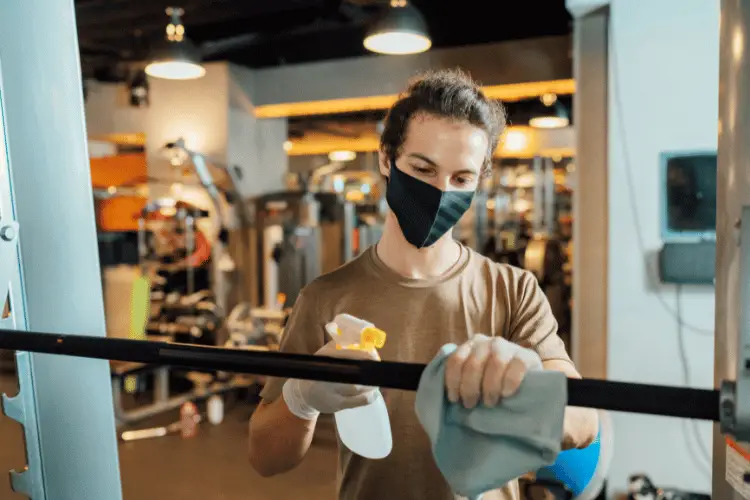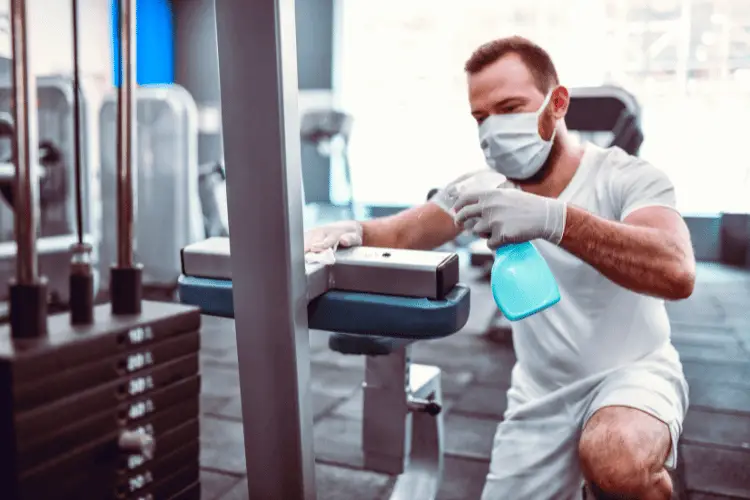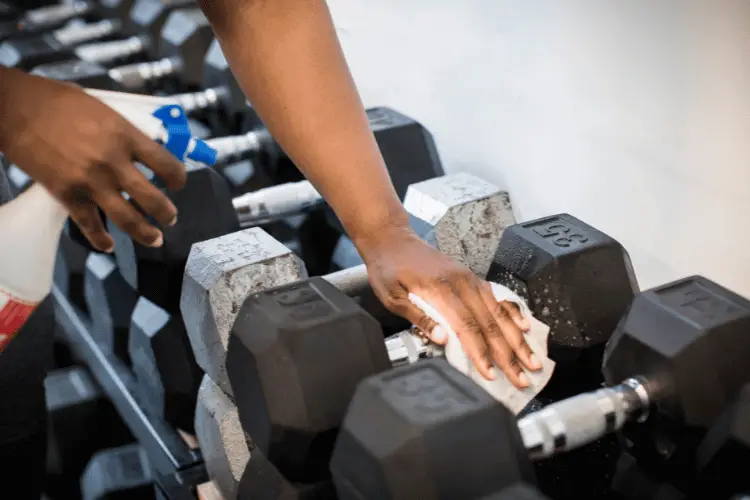Proper cleanliness is as crucial to a gym or fitness center as the very equipment it houses.
Before I became a personal trainer over 20 years ago, I started as a janitor in a gym. Since then, I’ve always had a hand in the cleaning protocols followed in any gym I was in.
In today’s article, I’ll be sharing a comprehensive guide on everything you need to know about keeping a gym clean. I’ll also be explaining the scope of its importance and advantages, as well as discussing the best practices for promoting gym cleanliness and hygiene.
Why Is It Important To Maintain Thorough Gym Cleanliness?
Cleanliness is vital for the success of any gym operation, but merely mentioning that isn’t enough to get owners and managers on board with providing all-out support and resources for the matter.
Understanding the reasons why gym cleanliness is an issue is the most effective way to ensure thorough and consistent enforcement of hygiene and sanitation guidelines across the facility.
Here are the top three cleanliness-related problems that occur in gyms:
1. A Lot of Germs Can Reside in Gyms
First of all, gym centers and fitness facilities are hot spots for the presence of microbes.
You may be thinking “Well, duh, everybody knows that”, but what you probably don’t realize is how big and diverse of a population we’re talking about. Bacteria, viruses, and fungi can easily make breeding grounds out of gyms.
- One of the most common bacteria found in gyms is staph bacteria. These can cause skin infections, food poisoning if ingested, and bacteremia (if they enter the bloodstream via a wound/cut).
- Dermatophytes are a prime example of fungi commonly occurring in gyms, especially locker rooms. These can cause Athlete’s foot, ringworm, and jock itch.
- HPV (human papillomavirus), herpes simplex virus, and airborne viruses are also common to come across in gym settings. These can cause plantar warts, mat herpes, and the flu.
Surfaces of stationary bikes, treadmills, mats, benches, faucets, free weights, and other typical equipment and rooms in gyms are examples of high-touch areas where you’re likely to make contact with germs.
- In this 2014 study, skin-contact surfaces in 4 fitness centers in Tennessee were sampled for bacterial presence and identification. Results found 17 families and 25 genera of bacteria.
- In this 2010 study, 10 athletic exercise facilities and locker rooms were tested for the presence of MRSA (Methicillin-resistant Staphylococcus aureus). Results showed that 9 out of 10 of the locations sampled had at least two positive MRSA surfaces.
2. Many Users Don’t Practice Adequate Hygiene
In addition to housing various types of bacteria, viruses, and fungi, another reason why gyms and fitness centers require strict cleaning routines is that users can make matters worse.
That’s because many gym-goers don’t stick to good hygiene practices. As shocking as it may be, it’s true that a lot of people have dirty gym habits. Let’s face it, it also just happens to be the time of day when they are sweating the most.

According to a Nuffield Health survey that included 2,000 gym users, the following statistics were observed at the gym:
- 74 percent (almost three-quarters) of people polled reported they had seen other members practice bad fitness etiquette. For example, not wiping sweaty equipment after they were done or leaving a dirty towel behind on a machine.
- 49 percent (almost half) of people polled said that they’re guilty of using something such as a water bottle, towel, or toiletry that did not belong to them.
- 16 percent of people polled confessed that there was at least one occasion where they didn’t wash their gym clothes between sessions.
- 35 percent (more than a third) of people polled disclosed that they exercise without wearing socks or deodorant.
- 18 percent of people polled admitted that they had gone to the gym while feeling unwell or suffering from sneezing, coughing, and colds.
- 22 percent of people polled said they were put off working out by poor hygiene.
In another survey of more than 1,000 gym-goers conducted by TreadmillReviews, the following insights were revealed:
- Over 51 percent of people had witnessed someone not wiping equipment after use. Ironically, 31 percent of respondents confessed to being guilty of this very behavior.
- Almost 10 percent of people had encountered someone leaving trash behind them
- Around 7 percent of people had seen someone spit in the water fountain.
3. Mildew and Mold Are a Threat
Gymnasiums, training facilities, and fitness centers are all places where high levels of heat and moisture are expected and common. The elevated humidity and temperature levels make these locations a favorable environment for the growth of mildew and mold.
Such growth doesn’t just look downright gross and will surely deter people from coming back to the gym, but it can have more severe consequences if not treated and kept under control.
Exposure to mildew and mold can cause gym staff and members a range of health problems -primarily respiratory issues- ranging from coughing and red/itchy skin or eyes to shortness of breath and fever.
This sort of endangering can put the gym in violation of health codes and lead to its closure.
And, as an additional note, this can happen anywhere whether you are in the desert or the swamp. While the humidity in the desert is much less than the swamp, the humidity inside an exercise room with a bunch of sweaty, hard-working people can get pretty high. Then they all toss their sweat-soaked towels in the dirty towel bin.
Please make sure those dirty towels get washed immediately.
How Does Thorough Gym Cleanliness Benefit the Facility?
Now that you have a better idea about the importance of maintaining a proper level of gym cleanliness, the following benefits will provide gym owners and managers with all the motivation they need to see the process through.
1. Prevents Cross-contamination and Spread of Disease
A rigorous cleaning system is the most effective way to curb cross-contamination and restrict the spread of germs and diseases. The biggest contributor to these issues is failing to properly sanitize gym equipment and surfaces across the facility.
According to a study done by FitRated (a gym equipment comparison platform) that examined 27 different pieces of equipment at 3 gyms, the following is true:
- At least 70 percent of the bacteria found have potentially harmful effects on human health.
- The number of germs found on the sampled free weights was about 362 times higher than that on an average toilet seat.
- The number of germs found on the sampled exercise bikes was about 39 times greater than that on a food court’s plastic tray.
- The number of germs found on the sampled treadmills was about 74 times more than that on a water faucet in a public bathroom.
By keeping equipment and high-contact surfaces across the gym clean, you’re inhibiting the spread of infectious microbes such as MRSA, staph bacteria, and influenza viruses.
As such, the chances of your customers catching something are lowered, which means they’re more likely to come back and stick to their workout schedule.
Not to mention, with staff members also less likely to get sick, you can better sustain a smooth operation around the gym.
2. Increases Membership Attraction and Retention
Adopting thorough cleanliness procedures is a sure way to maximize customer satisfaction, improve member retention, boost membership numbers, and raise the average revenue per member in a gym.
Think of it as leaving a good first impression and then living up to that impression with every encounter. The result is a higher chance of coming back to the same facility.
According to this IHRSA (International Health, Racquet & Sportsclub Association) report, 82 percent of gym goers believe that dirty gyms are more likely to house microbes.
- According to the same report, 56 percent (more than half) of gym members expect their clubs and centers to be free of microbes.
- 40 percent of gym members are worried about the spread of germs at the club or facility they’re currently using.
When people perceive a gym as clean, they’re more likely to be satisfied with it than those who regard the club as unclean.
Casual users who consider a gym clear are more likely to become members, whereas current members who deem their gym as clean are more likely to renew their memberships. According to the IHRSA report, 80 percent of gym members confirm this opinion.

From a business point of view, gym-goers are there to touch objects and move them around. As a gym owner or manager, you need to be prepared for this cleanliness-wise if you’re to charge members and users any decent amount for the gym’s services.
3. Prolongs the Lifespan of Equipment
The prices of exercise equipment are already high, and they just keep on getting more expensive.
When a machine gets damaged or broken, some people resort to buying used gear to overcome this obstacle. But as with many problems out there, prevention can save you from dealing with this hassle altogether.
Adopting a regular cleaning routine for the gym equipment using the proper cleaning tools and materials can extend their lifespan.
With repeated use of dirty equipment, the buildup of sweat, debris, and rust can cause its parts to jam or get stuck and eventually break down.
Additionally, setting up a maintenance schedule to preserve the good condition of machines leads to less frequent repairs and puts off the need for a replacement.
4. Enhances the Workout Experience
A clean gym boosts the overall fitness experience of members. Just imagine yourself working out in a neat, well-maintained facility, then imagine doing the same exact exercises in a dirty one where equipment is falling apart.
Where are you more likely to feel motivated? Which gym is more likely to get you to work out more often? Where are you more likely to exercise without worrying about touching germs?
I believe the answer is clear.
5. Ensures People’s Safety
Another benefit of executing a gym cleanliness/maintenance system is to ensure the safety of gym members and staff personnel.
Accidents caused by poor upkeep of the facility and its equipment can put the owner at risk of facing liability claims.
The most common type of accident that results in injuries in gymnasiums is slip and fall accidents. The top causes for these include:
- Spilled liquids on floors
- Sweat and liquids on the equipment
- Slippery floors after waxing
Best Practices for Improving Gym Cleanliness
Implementing and improving gym cleanliness requires a decent knowledge of customer psychology, management principles, germ presence conditions, and cleaning methods.
I’ve put together the following guideline of practices to set you on the right track.
1. Create a Hygiene-aware Environment
Encouraging hygienic behavior is a great way to get gym members to do their part in maintaining cleanliness. Hanging signs, setting up hand sanitizing stations, and handing out information flyers are all tips to boost hygiene awareness.
2. Establish a Cleaning Schedule
Developing a cleaning schedule helps keep the gym facilities and equipment consistently clean.
A schedule makes it easier to get the job done since you’re not allowing dirt and debris to build up for a long time and become stubborn. It also results in a smoother operation because each member of the staff will already know what to do and when to do it.
Here’s an outline for an effective cleaning schedule:
- Fitness equipment:
- Wipe and disinfect after every use.
- Clean, sanitize, and disinfect daily.
- Locker rooms:
- Sweep, mop, and disinfect surfaces daily.
- Tidy up and clean hourly.
- Deep clean once a week.
- Rubber floors:
- Clean and disinfect every day.
- Seal every 2 to 4 weeks depending on usage volume.
- Exercise mats:
- Clean and disinfect after every use.
- Seal every 2 to 4 weeks depending on usage volume.
- Deep clean with bleach every 3 to 4 months.
3. Clean Gym Equipment Properly
Choosing the right type of cleaner is essential for the proper cleaning of gym equipment.

Alcohol-based solutions and harsh chemicals such as bleach and ammonia that can be used on floors and other parts of the facility aren’t suitable for cleaning gym equipment.
Such cleaners can cause discoloration, corrosion, or cracking of vinyl and plastic components of the machines and gear.
This damage is mainly due to the alcohol and chemicals drying out the plastic, so applying a vinyl/plastic conditioner after cleaning is a must if you’ll be using these products.
Choosing a suitable cleaning tool is another important aspect to consider. You should never use a stiff bristle or wire brush for cleaning to avoid scratching the equipment.
To thoroughly clean gym equipment without ruining it, follow the simple steps below:
- Use a damp microfiber cloth and a gentle cleaner to remove surface dust, dirt, fingerprints, stains, and debris.
- Grime buildup on dumbbells and other equipment can be stubborn, so be firm but not harsh.
- Don’t dump the cleaning solution directly on machines to avoid wetting their electrical parts.
- Allow the equipment to air dry. Never subject them to heat (for example, from a hair dryer) to speed up the process.
- With surface dirt gone, move on to sanitization to get rid of lingering microbes. Use a microfiber cloth and an appropriate sanitizer; don’t spray the equipment directly.
- After the sanitizing solution air dries, resume cleaning with a disinfectant (EPA-registered) to get rid of bacteria and pathogens.
4. Address Gym Odors
The best -and the correct- way to deal with foul smells in the gym is to locate the cause and handle it as necessary.
Trying to cover up the odor with an air freshener will only delay resolving the problem until it becomes worse.
Providing ample ventilation and using a steam cleaner is effective in most cases. Performing periodic checks of toilets, drains, mats, and other suspicious sources of bad smells can help you pinpoint the culprit faster.
5. Identify and Focus On High-risk Areas
Besides gym equipment, common high-risk areas include:
Showers and Toilets
Modern gyms house showers and toilets where the continuous presence of high moisture levels makes for ideal locations for germs, odors, and dirt to thrive.
Daily disinfection is crucial to ensure proper cleanliness in these areas. Regular brushing and wiping down prevent the accumulation of grime and rust.
Additionally, routine checking of drainage is critical to avoid standing water where bacteria, mold, and fungi can easily break out.
Be sure to keep the walls and floors as dry as possible at all times to prevent slip and fall accidents.
Locker/Changing rooms
Every single gym member is bound to pass through these damp locations, so saying they’re high-contact areas would be an understatement.
From sweat to dirt to bacteria to fungi, all sorts of problematic agents can be found there. As such, daily or even hourly disinfection is vital for proper cleanliness.
Final Thoughts
Not only does gym cleanliness play a key role in preventing the spread of disease, avoiding accidents, and keeping machines in good condition, but it’s also essential for maintaining the quality of the gym’s service, increasing customer satisfaction, and growing the business.
In other words, everyone benefits from upholding cleanliness and hygiene rules in a gym; from goers to owners.
This is why enforcing gym cleanliness standards is such a widely discussed matter in the fitness world, and why gym management should prioritize and invest in effective hygiene practices.
References
- https://www.healthline.com/health-news/poor-gym-habits-and-the-germs-they-carry
- https://www.mayoclinic.org/diseases-conditions/staph-infections/symptoms-causes/syc-20356221
- https://www.aafp.org/pubs/afp/issues/2003/0101/p101.html
- https://www.nhs.uk/conditions/athletes-foot/
- https://www.cdc.gov/fungal/diseases/ringworm/index.html
- https://www.mayoclinic.org/diseases-conditions/jock-itch/symptoms-causes/syc-20353807
- https://www.webmd.com/skin-problems-and-treatments/understanding-plantar-warts-basics
- https://www.dhs.wisconsin.gov/disease/herpes-gladiatorum.htm
- https://www.ncbi.nlm.nih.gov/pmc/articles/PMC4276630/
- https://pubmed.ncbi.nlm.nih.gov/20104827/
- https://www.huffingtonpost.co.uk/2012/12/11/gym-could-make-you-ill-nu_n_2274691.html
- https://www.treadmillreviews.net/gym-etiquette/
- https://www.cdc.gov/mold/faqs.htm
- https://www.fitrated.com/resources/examining-gym-cleanliness/
- http://blog2.zogics.com/wp-content/uploads/2013/12/IHRSA_CleanlinessGuide.pdf
- https://www.thecoldwire.com/why-are-weights-so-expensive/
- https://fitnessmachinetechnicians.com/sweats-effect-on-your-fitness-equipment/
- https://www.tavss.com/library/slip-and-fall-accidents-at-the-gym.cfm
- https://allegianceclean.com/is-bleach-corrosive-to-plastic/
- https://plasticexpert.com/learn/plastic-failure-and-cleaning-products/
- https://www.epa.gov/pesticide-registration/selected-epa-registered-disinfectants



